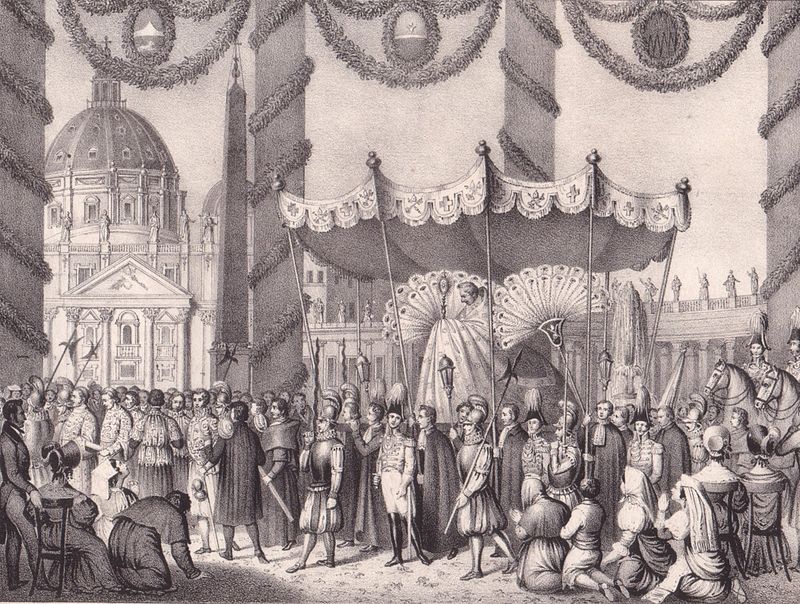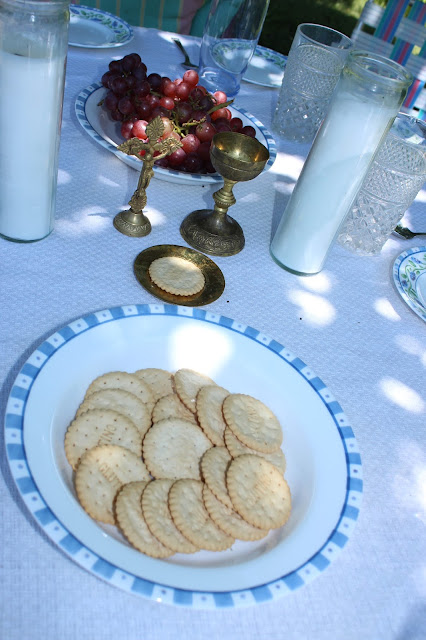This floating feast day was instituted in 1264 and is currently celebrated either on the Thursday or Sunday after Trinity Sunday, depending on your location. This day, also called the Feast of the Body and Blood of Christ, was inspired by a Eucharistic miracle and a vision of an Augustinian nun from Belgium named St. Juliana of Mont Cornillon and honors the Real Presence of Christ in the Eucharist.
 |
| Corpus Christi procession, BL Harley 7026, f. 13 (England, c.1400-c.1410 |
At our home, this year, Corpus Christi Thursday also was celebrated with a Poet-Tea.
A Feast of Corpus Christi Setting and Menu
{Disclosure: Some links which follow are affiliate ones.}
Since our final AMP It Up club meeting of the year fell on Corpus Christi Thursday, I suggested to the other family that would be coming that focus our Art, Music, and Poetry explorations on the liturgical celebration of Corpus Christi with a simple Poet-Tea. Thus, for Corpus Christi, our simple poet-tea table was decorated with:
- a white tablecloth (for purity)
- two white pillar candles (to represent altar candles)
- a mini chalice and paten from our miniature Mass kit (to represent the Body and Blood of Christ. You could also use a simple stemmed glass and small plate, parts of a life-size Mass Kit, or a Father Leopold Celebrated Mass custom Lego Kit.)
Had I had time to go out and get roses, I might have also strewn our table with petals and, for fun, even set up a peg doll or Lego procession. Perhaps next year...
Since the morning before our AMP club gathering was busy, however, I kept things super simple, including the symbolic drinks and foods that were minimal, meaningful, yet tasty:
- grape juice (representing wine which transforms into the Blood of Christ. Any red or purple juice, or even real wine, could, of course, also work)
- gluten-free Glutino crackers (representing the bread which transforms into the Body of Christ. Any round cracker, wafer candy, bread loaf, or even unconsecrated communion wafers - sometimes used by parents whose children need to practice for First Holy Communion - could work.)
- grapes (again, reminding us of wine)
- So Delicious casein-free vanilla "ice cream" cut into rounds with crosses pressed into them (to cool us off and remind us of the host and my children's First Holy Communion celebration desserts)
Our Outdoor Poet-Tea for Corpus Christi
Once our friends arrived for our Corpus Christi poet-tea, we gathered at our celebratory table set under the shade of a tree, and I asked the children what the foods laid out on it might remind them of. They answered, "The Last Supper!", "the Eucharist," "First Holy Communion," "the Fruit of the Spirit," and "the Holy Trinity". With this, I bridged into asking the children if they knew what solemnity is celebrated by the Church either 10 days after Pentecost or on the Sunday after Trinity Sunday - Corpus Christi!
I, then, asked the children to guess what the words "Corpus Christi" might mean, whereupon they suggested "the Body of Christ".
Using an infrographic downloaded from CBCPNews, we, then, chatted about the history and significance of the Corpus Christi, before gathering around my laptop to watch a brief video about Corpus Christi from Britannica Kids.
After sharing a few more thoughts about the day - and about Eucharistic miracles, which the children were quite interested in, we prayed grace and enjoyed our tea fare.While the children enjoyed some time to play and chat, we cleared the food and drink and placed paper and art supplies on the table. Then, when we called the children back from their break, I explained that while I was preparing for our gathering, I had looked poetry written especially for Corpus Christi or about the Body and Blood of Christ. In doing so, I had found fun, medieval riddle poems at a Clerk of Oxford which were originally from BL Royal 17 A XVI:
It seems white and is red;
It is alive, and seems dead;
It is flesh, and seems bread;
It is one, and seems two; [i.e. to be composed of many parts]
It is God's body, and no mo. [nothing else]
and DIMEV:
It seemeth white and it is red;
It is alive and seemeth dead;
It is flesh and seemeth bread;
And is true God in his Godhead.
The children got a kick out of looking at these poems written in old-style language and also enjoyed hearing me read their modern translations aloud. We chatted about what each line of the riddles might refer to based on the children's understanding of the Mystery go the Blessed Eucharist.
We also talked about how old Bibles and books were often illuminated.
I, then, explained that Corpus Christi inspires more modern poetry, too. As examples, I shared two sonnets from Malcom Guilte: Love's Choice (about the Sacrament itself) and This Table (about the communion table). In these poems, we noted rich words and phrases that brought sensations to mind and emotions to heart.
After that, I reminded the children that portions of Bible itself are considered poetry and shared how I had found an interesting concrete-poem style image of a Bible verse online at My Catholic Faith Ministries:
The children thought this image was "so cool", and I agreed!
I, then, recalled our past discussion about how hymns and songs are often simply poetry set to music. I explained that there are a number of such musical poems related to the Body and Blood of Christ, some of which they might know from Mass, Adoration, and other experiences.
I had considered sharing musical excerpts of such songs or reading their lyrics as poetry using the article Corpus Christi: Our Debt to St. Thomas Aquinas from Catholic Exhange and Catholic Culture's Corpus Christi Hymn section, but I could tell the children were getting antsy. Thus, I decided to simply play the Corpus Christi Sequence Hymn of St. Thomas Aquinas from YouTube as background while the children worked on their own poetic and artistic creations.
I suggested to the children that they use the simple supplies set on the table -- paper, pencils, colored pencils, Color Sticks, and Thin Stix -- to meet one of three challenges:
(1) Design a concrete poem inspired by Corpus Christi using your own words or words from the Bible. Then, decorate the border of it.
(2) Write any style poem you wish about Corpus Christi and, then, illuminate a portion of it.
(3) Write any style of poem you wish inspired by the Eucharist, and, then, make a separate illustration - perhaps a still-life using our candles, chalice, and paten.
Before turning on the Youtube music and having the children get down to creating, I offered them one last bit of inspiration by quickly chatting about the symbolism, using this excerpt from Catholic Culture as a resource:
"The usual symbol for the Holy Eucharist is a chalice, with a host rising out of it.
The chalice is shown with a hexagonal base, as a rule, symbolizing the Six Attributes of the Deity (power, wisdom, majesty, mercy, justice and love), and with a richly wrought stem of gold, studded with precious stones. The host is shown as the typical circular wafer, upon which may be imprinted the letters I. N. R. I., from which proceed rays of light, symbolical of the Real Presence, the substantial presence of Christ under the species of bread and wine.
An altar, upon which is set a cross, two or more candles in their tall candlesticks, a chalice and a ciborium, is another symbol often seen."
The children then set to work creating while listening to the music from my laptop. (Of course, YouTube has plenty of other Corpus Christi hymns, talks, etc. some of which contain beautiful art images, that we might have enjoyed if we were not outside enjoying the beautiful weather!)
Finally, the children shared their creations with one another...
and went off to play again.
Happy Corpus Christi!
O Lord Jesus Christ, You who have given us Your precious Body and Blood to be our meat and drink, grant that through frequent reception of You in the Holy Eucharist, I may be strengthened in mind and body to do Your holy will. Amen.
Jesus in the Blessed Sacrament, have mercy on us.
{Short Novena prayer from Catholicism.About.Com}
Please do share your own Corpus Christi traditions, prayers, recipes, resources, and ideas with us! We love discovering new ways to live the liturgical year in our domestic church.
O Lord Jesus Christ, You who have given us Your precious Body and Blood to be our meat and drink, grant that through frequent reception of You in the Holy Eucharist, I may be strengthened in mind and body to do Your holy will. Amen.
Jesus in the Blessed Sacrament, have mercy on us.
{Short Novena prayer from Catholicism.About.Com}
Please do share your own Corpus Christi traditions, prayers, recipes, resources, and ideas with us! We love discovering new ways to live the liturgical year in our domestic church.

















 Logging you in...
Logging you in...